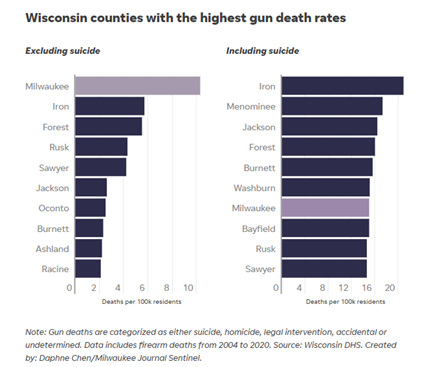
Office of Children's Mental Health (OCMH) Senior Research Analyst, Amy Marsman, spotlights recent articles, resources, and research findings impacting youth mental health.
|
Nearly all voters say youth mental health is a serious problem; large majority say social media has been a factor (Story)
A recent poll shows broad agreement on the desire to shield youth from online harms and highlights the deep concern about the state of youth mental health. Nearly all voters (94%) say that mental health challenges for children and teens are a serious problem today, including more than half (55%) who say it is a very serious problem. Among parents with kids under the age of 18, the “very” serious number increases to 66%. Three in four voters place the blame on social media—73% say that over the past 20 years social media has made youths’ mental health worse. The poll shows that vast majorities are looking to the government to address problems with social media and to put safeguards in place.
Suicide makes up 70% of gun deaths in Wisconsin
For every 100 fatal shootings in Wisconsin, on average 71 deaths are suicides, 25 are homicides, two are police shootings, one is deemed an accident, and the balance are undetermined, according to a Milwaukee Journal Sentinel analysis of state health data. Rural counties make up nine of the 10 hardest hit counties.

Integrating Behavioral Health Care into Primary Care Centers (Journal Article with Video Abstract)
Growing evidence suggests that integrated practices increase access and utilization of mental health services among youth, while reducing disparities and improving overall clinical outcomes. In this study, utilization of behavioral health services increased 143% in the sites that had embedded psychologists and a 93% increase in initial behavioral visits when they occurred on the same day. For those who were not seen on the same day, the wait was more than four times longer than the wait for those receiving care at sites with psychologists. Those who were seen quickly were also less likely to require more specialized behavioral health services.
Alternatives to Preschool Expulsions, the Pediatrician’s Role
Expulsion of young children ignores underlying emotional and behavioral concerns, disproportionately affects children of color, males, children with disabilities, socioeconomically disadvantaged populations, and has long-term negative consequences on educational and life success. For these reasons, the American Academy of Pediatrics (AAP) urges pediatricians, early learning professionals, and communities to provide alternatives to expulsion in an updated policy statement, “Addressing Early Education and Expulsion,” published in the November 2023 Pediatrics.
The AAP recommendations to prevent expulsion include: addressing implicit bias and providing child mental health consultation to child care providers; identifying children at risk for expulsion because of poverty, racial discrimination, toxic stress, insecure attachment, or history of trauma; connecting families with community resources that may ameliorate these effects; providing information on social-emotional development in early childhood; and promoting positive parent-child relationships. Their recommendations are consistent with knowledge of early child brain development and support the AAP position on the pediatrician’s role in building resilience and buffering toxic stress to promote optimal child development.
-
News Release: AAP Details Alternatives to Preschool Expulsions and Emphasizes Need to Address Deeper Health Concerns
-
Policy Statement: Addressing Early Education and Child Care Expulsion
-
Policy Explainer: Preventing Preschool Expulsions: AAP Policy Explained
New data from the CDC show Black children have the highest rate of emergency department (ED) visits for mental health concerns. (Story)
So many Black children and adolescents are visiting EDs for mental health concerns that it has become “a public health crisis.” Data reported by the CDC in late October showed that Black youth had the highest rate of mental health-related emergency department visits. Suicide attempts among Black youth have skyrocketed by 80 percent over the past 30 years.
The data didn’t surprise Ashley Maxie-Moreman, a Washington DC-based clinical psychologist who studies the impact of racism on Black youth, particularly in digital spaces. Her research shows that online exposure to racial discrimination and traumatic events can lead to increases in symptoms of trauma and thoughts of suicide. Online communities are just as susceptible to racism and discrimination as the ones experienced in-person. “Racial discrimination is really harmful for our kiddos,” Maxie-Moreman explained.
Black children are less likely to have access to therapy and stop using it more frequently, said psychiatrist Amanda Calhoun. Her young Black clients often report having tried therapy before seeing her, but say they stopped going after feeling dismissed, discriminated against, or misunderstood by their previous clinician. Ideally, she said, you would reach these kids before it’s a crisis, but the realities of finding a therapist that accepts your insurance, has availability, and understands what it means to be Black in America adds barriers.
Affirming Actions among trans and nonbinary youth (Research Brief)
New research from The Trevor Project asked transgender and nonbinary youth about when they feel gender euphoria. Gender euphoria is defined as satisfaction or joy caused when one’s gendered experience aligns with their gender identity, rather than with the gender they were assigned at birth. Researchers asked, “What are things that others do that make you feel happy (or euphoric) about your gender?” They reported several actions that evoked positive feelings across four areas: Affirming communication, inclusivity and belonging, appearance affirmation, and support and respect.
Children Who Survive Shootings Endure Huge Health Obstacles and Costs (KFF)
In the year after they were shot, child and adolescent survivors were more than twice as likely as other kids to experience a pain disorder, said Zirui Song, an associate professor of health care policy and medicine at Harvard Medical School and the co-author of a new study in Health Affairs. The shooting survivors in the study — age 19 and younger — were found to be 68% more likely than other kids to have a psychiatric diagnosis and 144% as likely to develop a substance use disorder. Teen pregnancy rates plummeted since peaking in 1991, but given changes in abortion laws and restrictions on sex education in schools, some anticipate an uptick.
Nationally, the rate of teen births has dropped by 78% since a modern-day peak in 1991. Starting in 2007, the rate had consistently dropped by about 8% until 2021, when the rate of decline slowed to about 2%.
Young people came back from the pandemic with record levels of mental health struggles, which can be intertwined with teen pregnancy. A person with mental health issues may be more likely to form unhealthy relationships and engage in riskier sexual behaviors.
The sudden shift in the reproductive health landscape concerns advocates and researchers even though most abortion patients are not teenagers. Teenagers account for only 9% of abortions and 6% of all pregnancies reported in the U.S. each year, according to a report by Child Trends. Yet, about 1 in 4 teens who do get pregnant in the U.S. will opt for an abortion, according to the Department of Health and Human Services.
Young adults in the U.S. report twice the rates of anxiety and depression as teens. (Story)
In a new report from Making Caring Common, the mental health challenges of young adults are detailed with several drivers of young adults’ emotional challenges – including a lack of meaning and purpose – being identified. The report, On Edge: Understanding and Preventing Young Adults’ Mental Health Challenges, lists additional drivers of stress: financial worries, pressure to achieve, global crises, lack of mattering, loneliness, and gun violence in schools.
Friendship in America (Survey Story)
Half of Americans say they have four or more close friends. 61% of U.S. adults say having close friends is extremely or very important for people to live a fulfilling life, according to a recent Pew Research Center survey. This is far higher than those who say the same about being married (23%), having children (26%), or having a lot of money (24%). The poll found women talk about their mental health more often than men do with close friends (31% vs. 15%). The gender gap on mental health is particularly wide among adults younger than 50: twice as many women (43%) in this age group, compared with 20% of men, say they often discuss mental health with close friends.
Another new study on friendship, the largest and most comprehensive of its kind, found that friendships in older adults were associated with better mental health across the board. In fact, it was reported that high-quality friendships were associated with many positive health behaviors and benefits: 17% reduced risk of depression, 19% lower likelihood of having a stroke, as well as 24% less likely to die during the eight-year period of research. Experts say the research shows how friendships and social connection are a potent public health opportunity.
Finally, a related story on intergenerational friendships, how they enrich lives, and how to cultivate these positive connections.
|